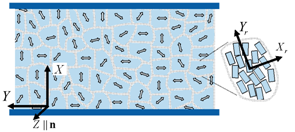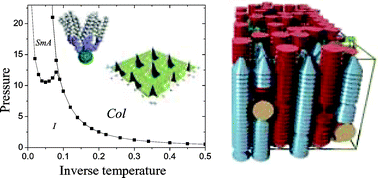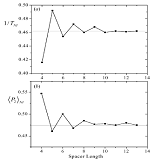A.G. Vanakaras and D.J. Photinos, J. Chem. Phys., 128, 154512 (2008).
 Abstract: An intermediate nematic phase is proposed for the interpretation of recent experimental results on phase biaxiality in bent-core nematic liquid crystals. The phase is macroscopically uniaxial but has microscopic biaxial, and possibly polar, domains. Under the action of an electric field, the phase acquires macroscopic biaxial ordering resulting from the collective alignment of the domains. A phenomenological theory is developed for the molecular order in this phase and for its transitions to purely uniaxial and to spontaneously biaxial nematic phases.
Abstract: An intermediate nematic phase is proposed for the interpretation of recent experimental results on phase biaxiality in bent-core nematic liquid crystals. The phase is macroscopically uniaxial but has microscopic biaxial, and possibly polar, domains. Under the action of an electric field, the phase acquires macroscopic biaxial ordering resulting from the collective alignment of the domains. A phenomenological theory is developed for the molecular order in this phase and for its transitions to purely uniaxial and to spontaneously biaxial nematic phases.
Related Works:
- Theory and simulation of biaxial nematic and orthogonal smectic phases formed by mixtures of board-like molecules, A. G. Vanakaras, M. A. Bates and D. J. Photinos, Phys. Chem. Chem. Phys. 5(17), 3700 (2003).
- The phase behavior of a binary mixture of rodlike and disclike mesogens: Monte Carlo simulation, theory, and experiment, A. Galindo, A. J. Haslam, S. Varga, G. Jackson, A. G. Vanakaras, D. J. Photinos and D. A. Dunmur, J. Chem. Phys. 119(10), 5216 (2003).
- On the Molecular requirements for the stabilization of thermotropic Biaxial ordering in Rod-Plate nematics, A. G. Vanakaras, A. F. Terzis and D.J. Photinos, Molec.Cryst. Liq. Cryst., 362, 67-78 (2001).
- Theory of biaxial nematic ordering in rod-disc mixtures revisited, A. G. Vanakaras and D.J. Photinos, Molec.Cryst. Liq. Cryst., 299, 65-71 (1997).
- Hydrogen bonding and phase biaxiality in nematic rod-plate mixtures, A. G. Vanakaras, S. C. McGrother, G. Jackson and D. J. Photinos, Molec.Cryst. Liq. Cryst., 323, 199 (1998).
http://www.matersci.upatras.gr/SoftMat/Research/PDF/JCP08_BiaxClusters.pdf
S.D. Peroukidis, A.G. Vanakaras and D.J. Photinos, J. Phys. Chem. B , 112(40), 12761-12767 (2008).
 Abstract: The molecular cubic-block model [J. Chem. Phys. 2005, 123, 164904] is used to study a class of poly(benzyl ether) fullerodendrimers that have recently been reported to form columnar liquid crystal phases. In agreement with experiment, the model-molecules are found to self-assemble into columns which form hexagonal or rectangular lattices. The columnar cross sections are elongated in the rectangular phase. Transitions to the isotropic phase, either directly or through the intermediate formation of smectic phases, have been found. The effects of dissolving small amounts of nonbonded fullerene molecules have been explored. The results predict that the fullerene solutes restrict the range of stability of the columnar phase and may induce transitions from the columnar to the smectic or the isotropic phase. ©2008 American Chemical Society
Abstract: The molecular cubic-block model [J. Chem. Phys. 2005, 123, 164904] is used to study a class of poly(benzyl ether) fullerodendrimers that have recently been reported to form columnar liquid crystal phases. In agreement with experiment, the model-molecules are found to self-assemble into columns which form hexagonal or rectangular lattices. The columnar cross sections are elongated in the rectangular phase. Transitions to the isotropic phase, either directly or through the intermediate formation of smectic phases, have been found. The effects of dissolving small amounts of nonbonded fullerene molecules have been explored. The results predict that the fullerene solutes restrict the range of stability of the columnar phase and may induce transitions from the columnar to the smectic or the isotropic phase. ©2008 American Chemical Society
Related Works:
, S. D. Peroukidis, A. G. Vanakaras and D. J. Photinos,
J. Chem. Phys.,
123, 164904 (2005).
, S. D. Peroukidis , A. G. Vanakaras and D. J. Photinos,
Soft Matter,
4, 493-499 (2008).
A. G. Vanakaras and D. J. Photinos,
J. Mater. Chem. 15, 2002-2012 (2005).
S.D. Peroukidis, A.G. Vanakaras and D. J. Photinos, Soft Matter, 4, 493-499 (2008).
 Abstract: A molecular model of cubic building blocks is used to describe the mesomorphism of conical fullerenomesogens. Calculations based on density functional molecular theory and on Monte Carlo computer simulations give qualitatively similar results that are also in good agreement with the experimentally observed mesomorphic behaviour. The columnar and lamellar mesophases obtained are non-polar, and their relative stability is controlled by a single model parameter representing the softness of the repulsive interactions among the building blocks of the conical molecules.
Abstract: A molecular model of cubic building blocks is used to describe the mesomorphism of conical fullerenomesogens. Calculations based on density functional molecular theory and on Monte Carlo computer simulations give qualitatively similar results that are also in good agreement with the experimentally observed mesomorphic behaviour. The columnar and lamellar mesophases obtained are non-polar, and their relative stability is controlled by a single model parameter representing the softness of the repulsive interactions among the building blocks of the conical molecules.
D. K. Christopoulos, A. F. Terzis, A. G. Vanakaras and D. J. Photinos, J. Chem. Phys., 125, 204907 (2006).
 Abstract: We present a molecular simulation study of the structure of linear dendronized polymers. We use excluded volume interactions in the context of a generic coarse grained molecular model whose geometrical parameters are tuned to represent a poly(paraphenylene) backbone with benzyl ether, Frechet-type dendrons. We apply Monte Carlo sampling in order to investigate the formation of packing-induced chiral structures along the polymer backbone of these chemically achiral systems. We find that helical structures can be formed, usually with defects consisting of domains with reversed helical handedness. Clear signs of helical arrangements of the dendrons begin to appear for dendritic generation g=4, while for g=5 these arrangements dominate and perfect helices can be observed as equilibrium structures obtained from certain types of starting configurations.
Abstract: We present a molecular simulation study of the structure of linear dendronized polymers. We use excluded volume interactions in the context of a generic coarse grained molecular model whose geometrical parameters are tuned to represent a poly(paraphenylene) backbone with benzyl ether, Frechet-type dendrons. We apply Monte Carlo sampling in order to investigate the formation of packing-induced chiral structures along the polymer backbone of these chemically achiral systems. We find that helical structures can be formed, usually with defects consisting of domains with reversed helical handedness. Clear signs of helical arrangements of the dendrons begin to appear for dendritic generation g=4, while for g=5 these arrangements dominate and perfect helices can be observed as equilibrium structures obtained from certain types of starting configurations.
A. G. Vanakaras, Langmuir, 22, 88-93 (2006).
 Abstract: The phase behavior and associated pattern formation of two-dimensional systems of hard disks decorated with amphiphilic coronae (Janus disks) are studied by means of Monte Carlo computer simulations. A primitive interaction potential that captures the essential interparticle interactions is introduced. Despite its simplicity, the system exhibits a very rich phase polymorphism. Apart from the isotropic phase and depending upon the coronal thickness, the simulated systems self-organize in a number of two-dimensional mesophases of various symmetries exhibiting a variety of novel patterns. The results of these simulations suggest that 2D Janus particles are promising candidates for bottom-up design of precise two-dimensional templates.
Abstract: The phase behavior and associated pattern formation of two-dimensional systems of hard disks decorated with amphiphilic coronae (Janus disks) are studied by means of Monte Carlo computer simulations. A primitive interaction potential that captures the essential interparticle interactions is introduced. Despite its simplicity, the system exhibits a very rich phase polymorphism. Apart from the isotropic phase and depending upon the coronal thickness, the simulated systems self-organize in a number of two-dimensional mesophases of various symmetries exhibiting a variety of novel patterns. The results of these simulations suggest that 2D Janus particles are promising candidates for bottom-up design of precise two-dimensional templates.
S.D. Peroukidis, A.G. Vanakaras and D.J. Photinos, J. Chem. Phys., 123, 164904 (2005).
(Selected for the November 7, 2005 issue of Virtual Journal of Nanoscale Science & Technology.)
Abstract: Systematic efforts to synthesize fullerene-containing liquid crystals have produced a variety of successful model compounds. We present a simple molecular theory, based on the interconverting shape approach [Vanakaras and Photinos, J. Mater. Chem. 15, 2002 (2005)], that relates the self-organization observed in these systems to their molecular structure. The interactions are modeled by dividing each molecule into a number of submolecular blocks to which specific interactions are assigned. Three types of blocks are introduced, corresponding to fullerene units, mesogenic units, and nonmesogenic linkage units. The blocks are constrained to move on a cubic three-dimensional lattice and molecular flexibility is allowed by retaining a number of representative conformations within the block representation of the molecule. Calculations are presented for a variety of molecular architectures including twin mesogenic branch monoadducts of C-60, twin dendromesogenic branch monoadducts, and conical (badminton shuttlecock) multiadducts of C-60. The dependence of the phase diagrams on the interaction parameters is explored. In spite of its many simplifications and the minimal molecular modeling used (three types of chemically distinct submolecular blocks with only repulsive interactions), the theory accounts remarkably well for the phase behavior of these systems.
On the molecular theory of dimer liquid crystals
P.K. Karahaliou, A.G. Vanakaras and D.J. Photinos, Liq. Cryst., 32, 1397-1407 (2005).
 Abstract: We present a statistical mechanics approximation scheme for the explicit treatment of spacer-mediated configurational correlations among the mesogenic units that form a dimer molecule. The approximation is applied to the description of the nematic phase of linear uniaxial dimers interacting via a standard molecular pair-potential. Transition temperatures, order parameters and pair correlation averages are calculated for different spacer lengths. The results readily reproduce the experimentally observed trends of phase transition thermodynamics and of dipolar correlations deduced from dielectric studies.
Abstract: We present a statistical mechanics approximation scheme for the explicit treatment of spacer-mediated configurational correlations among the mesogenic units that form a dimer molecule. The approximation is applied to the description of the nematic phase of linear uniaxial dimers interacting via a standard molecular pair-potential. Transition temperatures, order parameters and pair correlation averages are calculated for different spacer lengths. The results readily reproduce the experimentally observed trends of phase transition thermodynamics and of dipolar correlations deduced from dielectric studies.
A.G. Vanakaras and D.J. Photinos, J. Mater. Chem. 15, 2002-2012 (2005).
Abstract: We present tractable molecular theory descriptions of liquid crystalline dendrimers based on clearly defined approximations and in terms of the dominant interactions underlying the self-organisation of these large and complex supermolecular entities. We formulate the configurational partition function for dendrimers, taking explicit account of their conformations and segmental interactions. Two approximate schemes are presented: the first is based on the effective interactions of the dendrimers as a whole while the second scheme is based on the interactions among the mesogenic units contained in the dendrimers. Results of lattice calculations for phase transitions in the context of the first scheme are presented and they show that the minimal inclusion of shape anisotropy and of sub-molecular partitioning into chemically distinct parts is sufficient to reproduce the variety of phases and phase sequences observed experimentally and provides insights into the conformational aspect of these transitions. In the second scheme, the description of the dendromesogenic system reduces to that of an ensemble of mesogenic dimers. This scheme can be readily extended to the description liquid crystalline oligomers and polymers consisting of mesogenic units connected by flexible spacers in various architectures. It thus provides a unified approach for treating mesomorphic phase transitions of supermolecular and macromolecular systems that can be built by connecting the same submolecular units in topologically different ways.
Structure and Nanomechanics of Linear Dendronised Polymers: A Molecular Simulation Study, D. K. Christopoulos, D. J. Photinos, L. M. Stimson, A. F. Terzis and A. G. Vanakaras, J. Mater. Chem. 13, 2756-2764 (2003).
Abstract: We use Monte Carlo algorithms to simulate, on the atomistic scale, the structure and rigidity of model linear dendronised polymers (LDPs) consisting of a poly(para-phenylene) backbone with laterally substituted Frechet type dendritic units. A coarse-grained representation of united atoms interacting via steric repulsions is employed for the study of the equilibrium structure of single LDPs as a function of dendron generation, g. Backbone conformation averages and dendron mass distributions are calculated for g = 0 to 5 and are used to elucidate the mechanism of stiffening of the LDP with increasing g. Congestion-induced stiffening, reflecting on the response of the backbone to linear extension as well as to bend and torsion deformations, is clearly detected for g = 4 and is dramatically intensified at g = 5 where, in addition, strongly bent and twisted structures develop along the backbone contour and reduce appreciably the equilibrium elongation of the LDP.
A. G. Vanakaras and D. J. Photinos, Mol. Cryst. Liq. Cryst., 315, 213 (2003).
 Abstract: Various possibilities of polar self-organisation in low molar mass nematic, smectic and columnar liquid crystals are discussed with particular focus on the underlying molecular symmetries and interactions. Distinction is made between vector and pseudovector polarities, their quantification in terms of molecular order parameters and their relation to spontaneous electric polarisation and to molecular chirality. The understanding of the molecular mechanisms that give rise to polar ordering in existing lamellar and columnar phases may be useful for the design of new polar variants of common a-polar liquid crystals.
Abstract: Various possibilities of polar self-organisation in low molar mass nematic, smectic and columnar liquid crystals are discussed with particular focus on the underlying molecular symmetries and interactions. Distinction is made between vector and pseudovector polarities, their quantification in terms of molecular order parameters and their relation to spontaneous electric polarisation and to molecular chirality. The understanding of the molecular mechanisms that give rise to polar ordering in existing lamellar and columnar phases may be useful for the design of new polar variants of common a-polar liquid crystals.
 Abstract: An intermediate nematic phase is proposed for the interpretation of recent experimental results on phase biaxiality in bent-core nematic liquid crystals. The phase is macroscopically uniaxial but has microscopic biaxial, and possibly polar, domains. Under the action of an electric field, the phase acquires macroscopic biaxial ordering resulting from the collective alignment of the domains. A phenomenological theory is developed for the molecular order in this phase and for its transitions to purely uniaxial and to spontaneously biaxial nematic phases.
Abstract: An intermediate nematic phase is proposed for the interpretation of recent experimental results on phase biaxiality in bent-core nematic liquid crystals. The phase is macroscopically uniaxial but has microscopic biaxial, and possibly polar, domains. Under the action of an electric field, the phase acquires macroscopic biaxial ordering resulting from the collective alignment of the domains. A phenomenological theory is developed for the molecular order in this phase and for its transitions to purely uniaxial and to spontaneously biaxial nematic phases.



